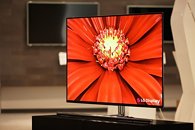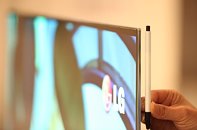Monday, December 26th 2011

LG Display Announces World's Largest OLED Panel
LG Display, a leading innovator of thin-film transistor liquid crystal display (TFT-LCD) technology, today announced that it has developed the world's largest 55-inch OLED(Organic Light Emitting Diodes) TV panel. The 55-inch panel is a significant step forward in the popularization of OLED TVs and demonstrates the effective application of AM OLED technology to larger panel sizes at a more cost efficient level.
"Our objective has always been to actively define and lead emerging display technology markets," said Dr. Sang Beom Han, CEO and Executive Vice President of LG Display. "Although OLED technology is seen as the future of TV display, the technology has been limited to smaller display sizes and by high costs, until now. LG Display's 55-inch OLED TV panel has overcome these barriers."Superior Image Quality in an Ultra Thin Design
LG Display's 55" OLED TV panel produces remarkable image quality with no after image due to its high reaction velocity, as well as high contrast ratio of over 100,000:1 and wider color gamut than that produced by LCD panels.
OLED, a medium that controls pixels is a departure from LCD panels which utilize liquid crystals. The new technology allows light emitting diodes to self-generate light and features a reaction velocity to electric signals over 1000 times faster than liquid crystal.
The environmentally conscious will also appreciate LG Display's 55" OLED TV panel. While light sources in backlight units, like LCD panels, must always be kept on, the OLED panel allows diodes to be turned on or off which enables lower power consumption than conventional LCD panels.
With no need for a special light source, LG Display's 55" OLED TV panel is also able to utilize a simplified structure thinner than that of a pen (5mm), and lighter than LCD panels. The panel's minimalist structure also allows for the realization of unique design elements.
Advancing the Popularization of OLED TVs
Although industry watchers anticipate OLED as the future of TV display, to date, the technology has faced challenges due to limitations on the sizes of displays it can be applied to and a high level of investment required. LG Display has successfully addressed these issues with its 55" OLED TV panel.
The panel adopts an Oxide TFT technology for backplane which is different from a Low Temperature Poly Silicon (LTPS) type generally used in existing small-sized OLED panels. The Oxide TFT type that LG Display utilizes is similar to the existing TFT process, with the simple difference lying in replacing Amorphous Silicon with Oxide. Moreover, the Oxide TFT type produces identical image quality to high performance of LTPS base panels at significantly reduced investment levels.
Additionally, LG Display uses White OLED (WOLED). WOLED vertically accumulates red, green, and blue diodes. With white color light emitting from the diode, it displays screen information through color layers below the TFT base panel, which leads to a lower error rate, higher productivity, and a clearer Ultra Definition screen via the benefits of small pixels. Further, it is possible to realize identical colors in diverse angles via color information displayed through a thin layer. Lower electricity consumption in web browsing environments for smart TVs is another key strength of WOLED.
Showing at CES 2012
The world's first 55" OLED TV panel from LG Display will be made available for showing to select media and customers at a private booth starting on January 9 in Las Vegas through the end of CES 2012. For information regarding a product tour, please contact the individuals listed below.
"Our objective has always been to actively define and lead emerging display technology markets," said Dr. Sang Beom Han, CEO and Executive Vice President of LG Display. "Although OLED technology is seen as the future of TV display, the technology has been limited to smaller display sizes and by high costs, until now. LG Display's 55-inch OLED TV panel has overcome these barriers."Superior Image Quality in an Ultra Thin Design
LG Display's 55" OLED TV panel produces remarkable image quality with no after image due to its high reaction velocity, as well as high contrast ratio of over 100,000:1 and wider color gamut than that produced by LCD panels.
OLED, a medium that controls pixels is a departure from LCD panels which utilize liquid crystals. The new technology allows light emitting diodes to self-generate light and features a reaction velocity to electric signals over 1000 times faster than liquid crystal.
The environmentally conscious will also appreciate LG Display's 55" OLED TV panel. While light sources in backlight units, like LCD panels, must always be kept on, the OLED panel allows diodes to be turned on or off which enables lower power consumption than conventional LCD panels.
With no need for a special light source, LG Display's 55" OLED TV panel is also able to utilize a simplified structure thinner than that of a pen (5mm), and lighter than LCD panels. The panel's minimalist structure also allows for the realization of unique design elements.
Advancing the Popularization of OLED TVs
Although industry watchers anticipate OLED as the future of TV display, to date, the technology has faced challenges due to limitations on the sizes of displays it can be applied to and a high level of investment required. LG Display has successfully addressed these issues with its 55" OLED TV panel.
The panel adopts an Oxide TFT technology for backplane which is different from a Low Temperature Poly Silicon (LTPS) type generally used in existing small-sized OLED panels. The Oxide TFT type that LG Display utilizes is similar to the existing TFT process, with the simple difference lying in replacing Amorphous Silicon with Oxide. Moreover, the Oxide TFT type produces identical image quality to high performance of LTPS base panels at significantly reduced investment levels.
Additionally, LG Display uses White OLED (WOLED). WOLED vertically accumulates red, green, and blue diodes. With white color light emitting from the diode, it displays screen information through color layers below the TFT base panel, which leads to a lower error rate, higher productivity, and a clearer Ultra Definition screen via the benefits of small pixels. Further, it is possible to realize identical colors in diverse angles via color information displayed through a thin layer. Lower electricity consumption in web browsing environments for smart TVs is another key strength of WOLED.
Showing at CES 2012
The world's first 55" OLED TV panel from LG Display will be made available for showing to select media and customers at a private booth starting on January 9 in Las Vegas through the end of CES 2012. For information regarding a product tour, please contact the individuals listed below.


23 Comments on LG Display Announces World's Largest OLED Panel
Perhaps any words about the resolution? I fear that if it is not mentioned they will stick with 1080p... such a shame.
i will gladly ship out moniez when there's something like that on the market, i'm staying with my shitty CRT till then :D
Anyways, I would love a 27 incher with 1080p on my desk ;)
Now all we need is 7970s in quad-fire... :eek:
With OLED, each pixel is a tiny light in itself, no back lighting required.
That's what I was trying to say. Most OLED displays use use sets of three OLEDs as individual pixels. In order to display red, the red subpixel is turned on and the other two subpixels are turned off.
But if you reread the OP, that doesn't sound like what we're dealing with here.It sounds more like this is an LCD screen with a WOLED backlight. The entire pixel is either on (white) or off (black). Color comes from the TFT. This is a step up from the WLED edge-lit TVs we're seeing now, as it allows for higher static contrast through local dimming, but it's a step back from true RGB-backlit TVs, and several steps back from a true OLED TV.
Sounds like it's OLED back lit to me as well now.
but at least it is a step in the right direction since none of the display makers were ever able to reliably build rgb-matrix oled displays with more than 10". the point is, that a tv has to last up to 8 years with a few hours of running time a day. this is not your average smartphone display you switch on for a couple of minutes just to check email. ;)
I can only imagine when that kind of tech will show up in 30", 4k panels with 1000hz refresh rate... Drool.
Even when they come round to socialise one girl I know as soon as she gets settled starts playing angry birds/other casual games and only stops to playing to drink her drink/smoke :laugh: